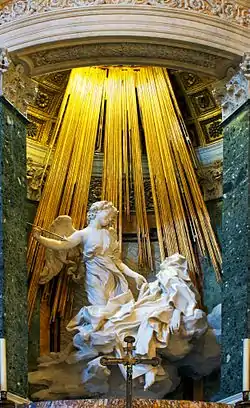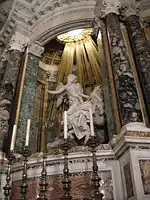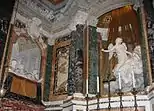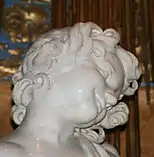| Ecstasy of Saint Teresa | |
|---|---|
 | |
Click on the map for a fullscreen view | |
| Artist | Gian Lorenzo Bernini |
| Year | 1647–1652 |
| Catalogue | 48 |
| Type | Sculpture |
| Medium | Marble |
| Dimensions | Life-size |
| Location | Santa Maria della Vittoria, Rome |
| 41°54′17″N 12°29′39″E / 41.90472°N 12.49417°E | |
| Preceded by | Raimondi Chapel |
| Followed by | Truth Unveiled by Time (Bernini) |
The Ecstasy of Saint Teresa (also known as Saint Teresa in Ecstasy or the Transverberation of Saint Teresa; Italian: L'Estasi di Santa Teresa or Santa Teresa in estasi) is a sculptural group in white marble set in an elevated aedicule in the Cornaro Chapel of the church of Santa Maria della Vittoria in Rome. It was designed and completed by Gian Lorenzo Bernini, the leading sculptor of his day, who also designed the setting of the Chapel in marble, stucco and paint. It is generally considered to be one of the sculptural masterpieces of the High Roman Baroque. The sculpture depicts Teresa of Ávila, a Spanish Carmelite nun and saint, swooning in a state of religious ecstasy, while an angel holding a spear stands over her.
Commission
The entire ensemble was overseen and completed by a mature Bernini during the Pamphili papacy of Innocent X. When Innocent acceded to the papal throne, he shunned Bernini's artistic services; the sculptor had been the favourite artist of the previous and profligate Barberini pope, Urban VIII. Without papal patronage, the services of Bernini's studio were therefore available to a patron such as the Venetian Cardinal Federico Cornaro (1579–1653).
Cornaro had chosen the hitherto unremarkable church of the Discalced Carmelites for his burial chapel.[lower-alpha 1] The selected site for the chapel was the left transept that had previously held an image of 'St. Paul in Ecstasy', which was replaced by Bernini's dramatization of a religious experience undergone and related by the first Discalced Carmelite saint, who had been canonised not long before, in 1622.[1] It was completed in 1652 for the then princely sum of 12,000 scudi.[lower-alpha 2]
A small format terracotta model of about 47 cm (19 in) was created between 1644 and 1647. The sculpture represents the first embodiment of the project, with traces of Bernini's fingerprints still visible. The model belongs to the Hermitage Museum's collection.[3]
Sculptural group and its setting

The two central sculptural figures of the swooning nun and the angel with the spear derive from an episode described by Teresa of Avila, a mystical cloistered Discalced Carmelite reformer and nun, in her autobiography, The Life of Teresa of Jesus (1515–1582). Her experience of religious ecstasy in her encounter with the angel is described as follows:
I saw in his hand a long spear of gold, and at the iron's point there seemed to be a little fire. He appeared to me to be thrusting it at times into my heart, and to pierce my very entrails; when he drew it out, he seemed to draw them out also, and to leave me all on fire with a great love of God. The pain was so great, that it made me moan; and yet so surpassing was the sweetness of this excessive pain, that I could not wish to be rid of it. The soul is satisfied now with nothing less than God. The pain is not bodily, but spiritual; though the body has its share in it. It is a caressing of love so sweet which now takes place between the soul and God, that I pray God of His goodness to make him experience it who may think that I am lying.[4]
The group is illuminated by natural light which filters through a hidden window in the dome of the surrounding aedicule, and underscored by gilded stucco rays. Teresa is shown lying on a cloud indicating that this is intended to be a divine apparition we are witnessing. Other witnesses appear on the side walls; life-size high-relief donor portraits of male members of the Cornaro family, e.g. Cardinal Federico Cornaro and Doge Giovanni I Cornaro, are present and shown discussing the event in boxes as if at the theatre. Although the figures are executed in white marble, the aedicule, wall panels and theatre boxes are made from coloured marbles. Above, the vault of the Chapel is frescoed with an illusionistic cherub-filled sky with the descending light of the Holy Ghost allegorized as a dove.
The art historian Rudolf Wittkower wrote:
In spite of the pictorial character of the design as a whole, Bernini differentiated between various degrees of reality, the members of the Cornaro Chapel seem to be alive like ourselves. They belong to our space and our world. The supernatural event of Teresa's vision is raised to a sphere of its own, removed from that of the beholder mainly by virtue of the isolating canopy and the heavenly light.[5]
- Gallery





Interpretations
The effects are theatrical,[6] the Cornaro family seeming to observe the scene from their boxes,[7] and the chapel illustrates a moment where divinity intrudes on an earthly body. Caroline Babcock speaks of Bernini's melding of sensual and spiritual pleasure as both intentional and influential on artists and writers of the day.[8] Irving Lavin said "the transverberation becomes a point of contact between earth and heaven, between matter and spirit".[9] As Bernini biographer Franco Mormando points out, although Bernini's point of departure for his depiction of Teresa's mystical experience was her own description, there were many details about the experience that she never specifies (e.g., the position of her body) and that Bernini simply supplied from his own artistic imagination, all with an aim of increasing the nearly transgressively sensual charge of the episode: "Certainly no other artist, in rendering the scene, before or after Bernini, dared as much in transforming the saint's appearance."[10]
Criticism
The sexual implications of the work have not gone unnoticed. Critics of the work are divided as to whether Teresa is experiencing divine joy or physical orgasm.[11] Many have expressed outrage.[12][13][14][15][16] It is considered Bernini's "most controversial work"[17]; "the most risqué of religious sculptures in Christendom"[18]; and "the most striking example of Bernini's marriage of sex and the sacred."[19]
Some have defended it, with historian Franco Mormando arguing that these defences take one of three approaches:
1. Bernini faithfully followed Teresa’s description of the experience.
2. The Church accepted that mystical union often involved erotic elements.
3. There is no nudity in the statue, so it does not violate decorum.[20][21]
However, Mormando argues 'none of these defenses are completely accurate.'[22]
Although some art historians insist that Bernini could not possibly have meant to imply eroticism, the sexual implications of the work are unmistakable: a beautiful, bare-chested young angel opens Theresa's dress, preparing to penetrate her with his arrow, while the saint throws back her head in ecstasy.[23]
Historians familiar with Bernini's torrid personal life are unsurprised by his wantonness.[24][25][26] Bernini's mantra was: “Those who never dare to break the rules never surpass them.”[27] He rebuffed those who criticised his industriousness with the retort: “Let me be; for I am in love,” and would refer to the statues he sculpted as his lovers (innammorate)[28][29]. ‘Better a poor Catholic than a good heretic,’ he quipped.[30] Interpreting religious topics with "radical artistic license," he helped establish a Baroque art movement through which artists "mischievously explore physical appetites using religious subject matter."[31]
Whereas Bernini considered the Ecstasy of Saint Teresa to be "the least bad thing I have ever done"[32], art critic John Ruskin strongly disagreed, saying it would be "impossible for false taste and base feeling to sink any lower."[33] Likewise, Victorian art critic Anna Jameson utterly despised it, calling it "the grossest and most offensive example of Baroque art," and said that "even those least destructive and prudish in matters of art, would here willingly throw the first stone."[34]
Misinterpretations
Angels & Demons is a novel written by Dan Brown. Two of his assertions are unjustified.
1) Brown says The Ecstasy of St. Teresa was moved from the Vatican after it was completed. In fact, the sculpture was never in the Vatican.
2) Brown says Pope Urban VIII criticised The Ecstasy of St. Teresa. In fact, Bernini began work on it after Urban's death.[35]
Similar works by Bernini
- See also entry titled Bernini's Cornaro chapel found in the Baroque section.
- Death of the Blessed Ludovica Albertoni (1671–1674)—San Francesco a Ripa, Rome.
- Martyrdom of Saint Lawrence (1614–15)[36]
- Truth Unveiled by Time (1646–1652) – Galleria Borghese, Rome.[37]
Influencing or influenced works
- Stefano Maderno's sculpture of St Cecilia in namesake church (1600).
- Melchiorre Caffà's Santa Rose of Lima (1665) and his Assumption of St Catherine.
- Francisco Aprile and Ercole Ferrata's Sant'Anastasia in her namesake church in Rome.
- The most internationally successful Czech underground group the Ecstasy of Saint Theresa named themselves after the sculpture.
- Angels & Demons, the novel by Dan Brown which lists the sculpture as the third "Altar of Science" of the fictionalized Illuminati. Brown's book incorrectly states that the sculpture was moved from the Vatican to its current location, and that Pope Urban VIII (who was already deceased when Bernini work on the sculpture) found the statue too sexually explicit.[38]
- The sculpture is the subject of the song "The Lie" from the Peter Hammill album The Silent Corner and the Empty Stage.[39]
- In Infinite Jest by David Foster Wallace, the sculpture plays a role in the filmography of James O. Incandenza, Jr. Wallace also alludes to it in three additional scenes involving Joelle.[40]
- Street artist Banksy used the image of Saint Theresa in one of his works, though he removed the angelic figure and added a fast food meal.[41]
- The sculpture and its image are frequently referred to in the novel Cutting for Stone by Abraham Verghese.
- In the psychoanalytic theories of Jacques Lacan, the statue plays an important role due to a central reference in his book Seminar XX: Encore. Lacan believes the statue helps convey his theory of the possibility of a female enjoyment that is infinite and unknowable, while masculine enjoyment is defined by finitude and failure. Some book covers of Seminar XX have a picture of the statue on the front.
See also
References
- Notes
- ↑ Cornaro had reason to avoid burial in Venice, since his appointment as a cardinal by Urban VIII while his father Giovanni was Doge had created a furor in his home-city, which banned families from holding such powerful positions simultaneously.
- ↑ Corresponding to c. $120,000[2]
- Citations
- ↑ Boucher 1998, p. 135
- ↑ Italian Baroque Sculpture : Books : Thames & Hudson
- ↑ Hermitage Museum, The State. "The Ecstasy of St Teresa". Hermitage Museum. Archived from the original on 20 May 2021. Retrieved 24 March 2021.
- ↑ Teresa of Avila (1515–1582). The Life of Teresa of Jesus. Chapter XXIX; Part 17.
- ↑ Wittkower, Rudolf (1980). Art and Architecture in Italy 1600–1750, Pelican History of Art. p. 160.
- ↑ Greer, Thomas H.; Lewis, Gavin (2005). A Brief History of the Western World. p. 392.
- ↑ "Bernini, Ecstasy of Saint Teresa". Khan Academy.
- ↑ "Caroline Babcock". academia.edu.
- ↑ Boucher 1998, p. 138
- ↑ Mormando, Franco (2 October 2023). "Did Bernini's Ecstasy of St. Teresa cross a seventeenth-century line of decorum?". Word & Image. 39 (4): 351–383. doi:10.1080/02666286.2023.2180931. ISSN 0266-6286.
- ↑ "Ecstasy of Saint Teresa by Bernini: Composition, Meaning". www.visual-arts-cork.com. Retrieved 15 January 2024.
- ↑ "Did Bernini's Ecstasy of Saint Teresa Cross the Line?". TheCollector. 21 May 2022. Retrieved 15 January 2024.
- ↑ Galindo, Giselle (9 December 2022). "Ecstacy of Saint Teresa Analysis". Medium. Retrieved 15 January 2024.
- ↑ "The Ecstasy of Saint Theresa". Artble. Retrieved 15 January 2024.
- ↑ "The Ecstasy & Controversy of Bernini's Saint Teresa, essay by John Moore". www.booksie.com. Retrieved 15 January 2024.
- ↑ "Did Bernini's Ecstasy of St. Teresa Cross a 17th-century Line of Decorum?" (PDF). Retrieved 15 January 2024.
- ↑ Mormando, Franco (2 October 2023). "Did Bernini's Ecstasy of St. Teresa cross a seventeenth-century line of decorum?". Word & Image. 39 (4): 351–383. doi:10.1080/02666286.2023.2180931. ISSN 0266-6286.
- ↑ "The Genius of Bernini, Rome's Most Famous Sculptor". 28 June 2016. Retrieved 15 January 2024.
- ↑ Gotthardt, Alexxa (13 April 2017). "How Bernini Captured the Power of Human Sexuality in Stone". Artsy. Retrieved 15 January 2024.
- ↑ Mormando, Franco (2 October 2023). "Did Bernini's Ecstasy of St. Teresa cross a seventeenth-century line of decorum?". Word & Image. 39 (4): 351–383. doi:10.1080/02666286.2023.2180931. ISSN 0266-6286.
- ↑ "The Ecstasy & Controversy of Bernini's Saint Teresa, essay by John Moore". www.booksie.com. Retrieved 15 January 2024.
- ↑ Mormando, Franco (2 October 2023). "Did Bernini's Ecstasy of St. Teresa cross a seventeenth-century line of decorum?". Word & Image. 39 (4): 351–383. doi:10.1080/02666286.2023.2180931. ISSN 0266-6286.
- ↑ "The Ecstasy of Saint Theresa". Artble. Retrieved 15 January 2024.
- ↑ SearchingForBernini (4 November 2015). "Bernini's Torrid Love Life". Searching For Bernini. Retrieved 15 January 2024.
- ↑ "Baroque Visions and Troubled Genius: Caravaggio, Bernini and Borromini in Rome". Through Eternity Tours. Retrieved 15 January 2024.
- ↑ "Bernini – His Life and His Rome (Emersion: Emergent Village resources for communities of faith): Amazon.co.uk: Mormando, F: 9780226538525: Books". www.amazon.co.uk. Retrieved 15 January 2024.
- ↑ Gotthardt, Alexxa (13 April 2017). "How Bernini Captured the Power of Human Sexuality in Stone". Artsy. Retrieved 15 January 2024.
- ↑ Gotthardt, Alexxa (13 April 2017). "How Bernini Captured the Power of Human Sexuality in Stone". Artsy. Retrieved 15 January 2024.
- ↑ Bolland, Andrea (2000). "Desiderio and Diletto: Vision, Touch, and the Poetics of Bernini's Apollo and Daphne". The Art Bulletin. 82 (2): 309–330. doi:10.2307/3051379. ISSN 0004-3079.
- ↑ "Bernini and Rome | History Today". www.historytoday.com. Retrieved 15 January 2024.
- ↑ "How Bernini Captured the Power of Ancient Greek Sexuality in Stone". GHD. 29 December 2020. Retrieved 15 January 2024.
- ↑ "Gian Lorenzo Bernini: 11 Facts About The Leader Of Baroque Sculpture". TheCollector. 17 July 2020. Retrieved 15 January 2024.
- ↑ "The Ecstasy of Saint Theresa". Artble. Retrieved 15 January 2024.
- ↑ "A Victorian Woman's Look at Bernini's Ecstasy of St. Teresa" (PDF). Retrieved 15 January 2024.
- ↑ "Dan Brown Rushes In Where Angels (and Demons) Fear to Tread". Catholic Answers. Retrieved 15 January 2024.
- ↑ "Web Gallery of Art, image collection, virtual museum, searchable database of European fine arts (1000–1900)". wga.hu.
- ↑ "Truth Unveiled by Time". Official Site Borghese Gallery Bernini. Archived from the original on 25 October 2005.
- ↑ Olson, Carl (4 January 2009). "Dan Brown Rushes In Where Angels (and Demons) Fear to Tread". Catholic Answers. Retrieved 13 January 2024.
- ↑ "The Lie (Bernini's Saint Theresa) de Peter Hammill". Archived from the original on 25 April 2012. Retrieved 20 October 2011.
- ↑ "A Field Guide to Occurrences of Bernini's Ecstasy of St. Teresa in Infinite Jest – Infinite Detox". Infinite Detox. 20 August 2009.
- ↑ "Banksy". banksy.co.uk. Archived from the original on 21 October 2007.
- Sources
- Hibbard, Howard. Bernini.
- Robert Harbison (2000). "The Case for Disruption". Reflections on Baroque. The University of Chicago Press. pp. 1–32.
- Boucher, Bruce (1998). Thames & Hudson, World of Art (ed.). Italian Baroque Sculpture. pp. 134–143. Archived from the original on 28 December 2005.
- Bernini biography (click on Ecstasy of St Teresa)
- Cocke, Richard (August 1972). "A Drawing by Bernini for the Cornaro Chapel, S. Maria della Vittoria". The Burlington Magazine. The Burlington Magazine Publications Ltd. 114 (833): 550–553. JSTOR 877068.
External links
| External videos | |
|---|---|
 Media related to Ecstasy of Saint Theresa of Avila by Bernini at Wikimedia Commons
Media related to Ecstasy of Saint Theresa of Avila by Bernini at Wikimedia Commons
| Preceded by Ludovisi Battle sarcophagus |
Landmarks of Rome Ecstasy of Saint Teresa |
Succeeded by Raphael Rooms |